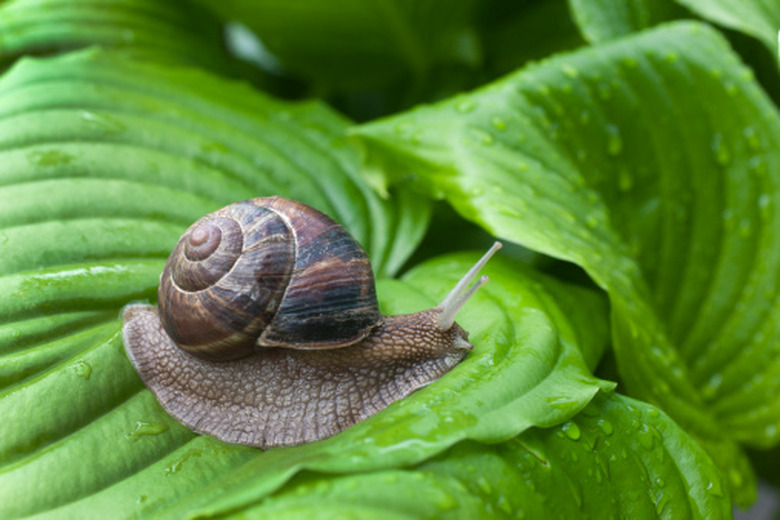Natural Snail Repellent
Snails are considered pests by many gardeners since they can damage or even destroy plants. For an effective, natural way to repel snails and prevent them from ruining your garden, erect some barriers that snails won't cross.
Snail Features
Snails move by gliding along a trail of mucus secreted by their foot muscle. They feed on both living and decaying plant material, injuring them by chewing holes into leaves, fruit and bark. They often destroy young seedlings in the process. Picking snails from your yard by hand is one chemical-free way to remove them, but it can be hard to find them since they usually come out at night.
Copper Repellents
Copper barriers are a natural repellent for snails. Thin sheets of copper placed around pots and tree trunks prevent snails from climbing up. Snails do not like to touch copper, apparently because the copper reacts with the snail's slime trail and creates an electrical shock. Strips of copper nailed along the sides of raised garden beds will prevent snails from making their way inside. If possible, bury the bottom of the copper strips into the ground 1 to 2 inches to prevent the snail from digging underneath the barrier.
- Snails are considered pests by many gardeners since they can damage or even destroy plants.
- For an effective, natural way to repel snails and prevent them from ruining your garden, erect some barriers that snails won't cross.
Dry Line Repellents
Dry lines of naturally abrasive material such as sawdust, ashes and diatomaceous earth act as barriers to prevent snails from migrating into protected areas. Snails don't like to cross these lines but the repellents are only effective if they stay dry. These barrier lines should be about 1 inch high and 3 inches wide to discourage the snails from attempting to cross.
Snail Repellent
Because snails are soft-bodied invertebrates (no backbone), they are damaged by substances that scratch their bodies. Surrounding desirable plantings with these substances creates a barrier that snails avoid to keep from causing themselves injury. Pinning down sandpaper around an area or securing it to a tree trunk repels snails. Certain plants can be very sensitive to salts, and repeat applications may increase soil salinity enough to damage the plant. Mineral oils can be painted on trunks, pots or on a raised bed structure, but they will soak into the ground if placed directly on soils. To be effective, the tape has to be wide enough so that snails can't arch across it. Aluminum foil is a less costly substitute. hardy in USDA zones 9 through 11; garlic (Allium spp. ),
- Dry lines of naturally abrasive material such as sawdust, ashes and diatomaceous earth act as barriers to prevent snails from migrating into protected areas.
- To be effective, the tape has to be wide enough so that snails can't arch across it.
References
- University of California Statewide Integrated Pest Management Program: Pests in Gardens and Landscapes: Snails and Slugs
- University of Florida: Mid-Florida Research & Education Center: Insect and Arthropod Pest Identification and Management
- African Journal of Agricultural: Mineral Oil as a Repellent in Comparison with Other Control Methods for Citrus Brown Snail, Caucasotachea Lencoranea
- Reader's Digest: 9 Unusual Uses for Eggshells
- Oregon Orchid Society: Slugs & Snails
- University of California: Snails and Slugs
- King County: Slug Prevention
- City of Santa Monica: Controlling Snails and Slugs in Your Garden
- The Telegraph: Garlic Proves the Kiss of Death to Slugs and Snails
- BioExpedition Publishing: Top Facts About Snails
- University of Hawaii: Barriers, Repellents and Antifeedants for Slug and Snail Control
